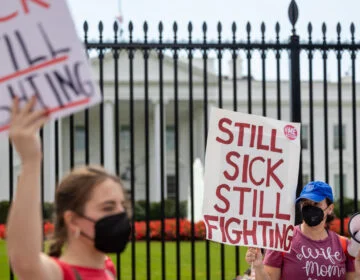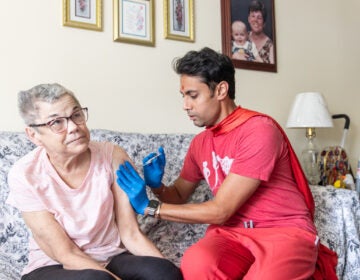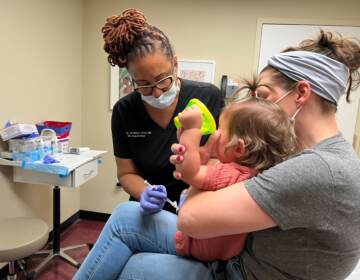Private medical practices suffer from the coronavirus’s many complications
Physicians providing outpatient care say they are losing business, which affects their staff. They also lack PPE and COVID testing supplies.
Listen 1:56
Philly City Foot Doc podiatrists (from left) Priscilla Howie, Kim Nguyen and Michael Walinsky outside their South Street offices. (Emma Lee/WHYY)
Throughout its rich history, Pediatric and Adolescent Medical Centers of Philadelphia has seen its ups and downs.
“We’ve been in business for 70 years … we know how to work on zero margins,” said William King Jr., a pediatrician at PAMCOP.
Its three locations are in Germantown, West Philadelphia, and Wilmington, each consisting of a physician and a two- to three-employee support staff. The offices may be small, but each is responsible for 2,500 to 4,000 patients, mostly from African American communities in the surrounding neighborhoods, but also from elsewhere around the region.
What is PAMCOP’s Germantown office today, King said, originally belonged to Albert Gaskins, a prominent pediatrician and civil rights figure in Philadelphia during the 1950s and 1960s. PAMCOP has been incorporating practices and physicians’ patients since it’s been around, he noted.
“It’s not just that I’m a Black pediatrician, I’m a pediatrician in the ‘old Black private practice,’ you know?” King said. “It’s kinda like saying Esperanza, that’s not just an organization. It is the organization, you know? Or Rita’s Water Ice, or Reading Terminal.”
PAMCOP is used to running on a tight budget, but the coronavirus pandemic has brought a new wave of problems and complications.
“We just try to make enough to not be out of business. But with COVID, we did have to furlough our office managers because one of them was a cancer survivor and one of them has a lot of respiratory problems. And so we were like … ‘you can go out on unemployment, until we can get more personal protective equipment.’ We have [had] to move very judiciously and efficiently in order to make it work.”
PAMCOP closed its Wilmington office entirely to avoid exposing the doctor working at that location, who is older, to the virus. On top of that, King and his colleagues took pay cuts because they are not seeing as many patients and are conducting only well visits.
Staff reductions and financial hits resulting from COVID-19 precautions are part of a growing and concerning pattern throughout Pennsylvania. Based on responses to an April online survey by Rockpointe in collaboration with the Pennsylvania Medical Society, physicians and practice administrators reported reductions of at least half their clerical staff (26% of respondents), nursing staff (21%,) nurse practitioner/physician’s assistant staff (18%), and physicians (12%).
PPE concerns
Shortages of PPE are significant because private practices, and in particular primary care practices, have been serving at the front of the frontlines.
“We hear a lot about frontline health care workers in hospitals dealing with sick patients in hospitals … without access to PPE. Well, those patients, before they were hospitalized, many of them would have gone in to see their … primary care practices. And their supply chain for those primary care practices is even more broken,” said Farzad Mostashari, a physician and CEO of Aledade, a company that provides support services to such practices. He spoke at a May teleconference put together by the Robert Wood Johnson Foundation that examined the impact of COVID-19 on primary care and outpatient services.
According to the Pennsylvania Medical Society survey, 56% of outpatient practices responding reported having only a two-week supply or less of PPE, and what they do have is mostly reserved for health care workers, since they often don’t have enough for clerical staff.
“We couldn’t get masks and gowns. So that’s why we couldn’t stay open [on the usual schedule],” King said. “If one of us gets COVID, we’re down for two weeks’ quarantine, which means our office is closed, which means we’re out of business for two weeks.”
Should that occur, the economic consequences would be substantial.
“Sick patients can’t come in. And that’s half of our bread-and-butter business,” said King. “A small practice is like a restaurant. A large practice is like Walmart. See, they have lots of income streams, but we’re really just that restaurant. If patients aren’t coming in, we make zero money … no business means no business.”
According to reporting by Dan Gorenstein, host of the health care podcast “Tradeoffs,” the American Academy of Family Physicians said many of its nearly 135,000 members reported seeing half as many patients as normal and having just two to six weeks’ worth of cash reserves in their practices.
The organization estimated that by June, 60,000 family practices would close or be significantly scaled back, and that 800,000 employees would be laid off, furloughed or have their hours cut.
Responses to the Pennsylvania Medical Society survey showed that more than one-third of practices had their patient loads cut by at least 76% since the pandemic began. Fifty-six percent of respondents said the number of procedures being performed was down by at least three-quarters; 12% had closed their practices either temporarily or permanently; and 18% were not sure if they would close.
What it means for patients
Meredith Rosenthal, a health economist at Harvard who studies primary care, said the loss of independent physician practices nationwide will have a detrimental effect on patient health and the cost of care overall.
“A loss of primary care capacity will have negative outcomes for the system as a whole, and certainly for those patients who have a loss of access.”
Mostashari, the CEO of Aledade, echoed those concerns. He said lack of access to preventative care is affecting health outcomes already.
“There’s a … second hidden pandemic of untreated chronic conditions that we should all be worried about,” Mostashari said. “If you don’t do prevention, you will pay the prices in complications and heart attacks and kidney failures and strokes … we should all be very worried about the untreated chronic diseases. And we’ve already seen some evidence [in] places like New York City, people [are] avoiding care, needed care, and [are] having bad outcomes, including in-home cardiac deaths as a result.”
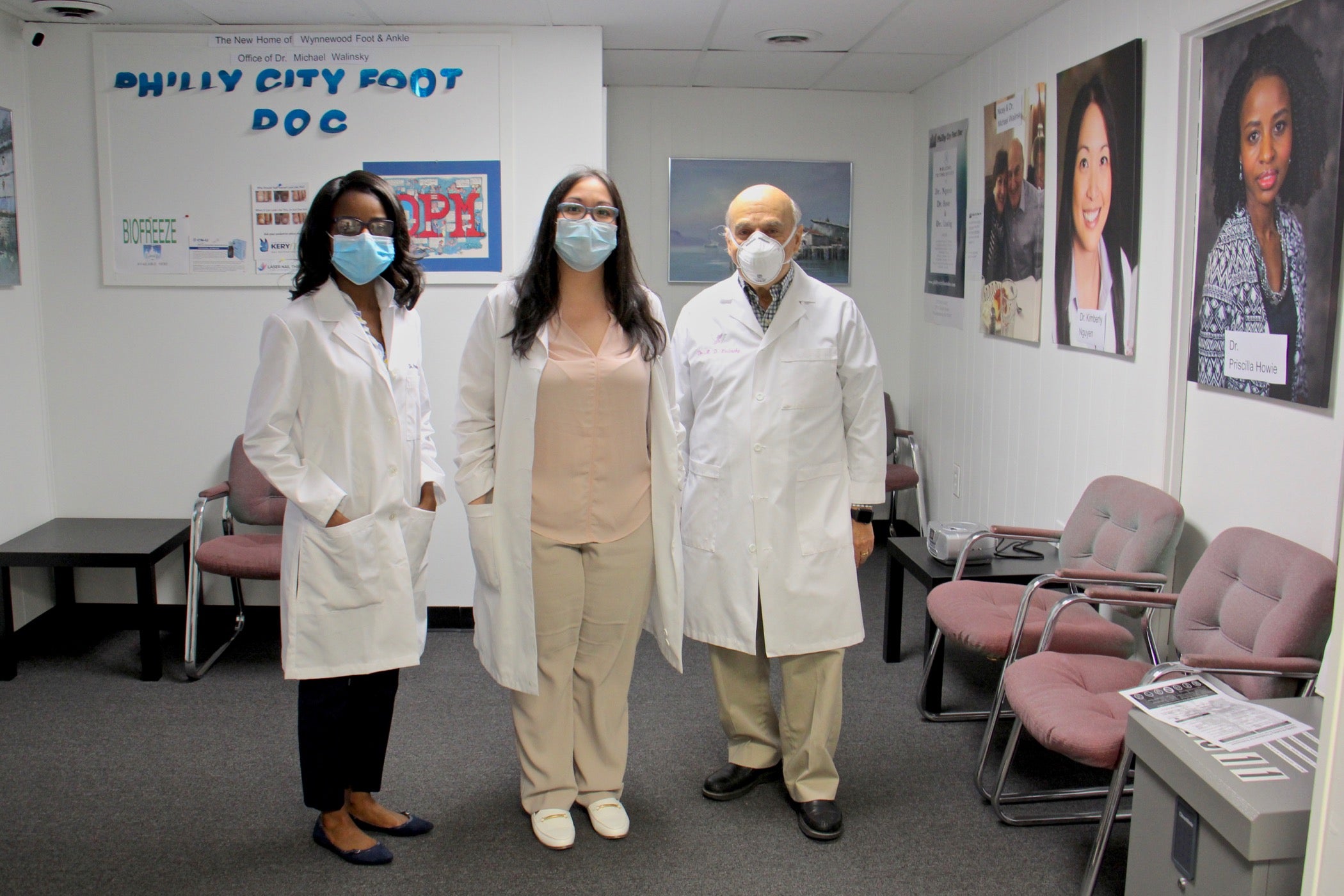
Kimberly Nguyen, a podiatrist at Philly Foot Doc on South Street, said she’s especially worried about her diabetic patients.
“What happens with a lot of diabetic patients is they can’t feel their feet. So they get a wound. They don’t see their foot doctor regularly, they get a wound that gets infected,” Nguyen said. “Once the wound gets infected and hits bone, they need an amputation.”
Sometimes, patients live alone and might not have another set of eyes to look at how dire their situation might be, she said. Sometimes, even if the patients do understand their risks, they might be too scared to go to the hospital or to go see their foot doctor. That delay might worsen the condition.
“So when all this is over, you know, they can have a raging infection, and that brings them into the hospital and they end up losing their leg or even their life if they get septic,” Nguyen said. “So I do worry about those people … Like, there are a million things that can happen to a diabetic patient that doesn’t take care of themselves.”
Telehealth: Not all it’s cracked up to be
Many hospitals and clinics are slowly bringing back elective surgeries and procedures that are, for the most part, safe. At the same time, doctors like Nguyen are still trying to be cautious and rely on telehealth services to monitor their patients.
But telehealth can be a bit tricky and can make it harder for doctors to check in on patients they’re especially worried about.
“There’s always, you know, concern for the elderly patients that we take care of if we’re not seeing them on a regular basis, that they sort of drift out of control from one chronic illness or another. So the telehealth certainly helps, but it is limited,” said Karl Schwabe, an internist with PMA Medical Specialists with an office in Havertown.
“I have a few people who I’m totally dependent on the patients’ children to set up [telehealth sessions], set up our meetings, so I can take a look at them. And, without that, I mean, we’d sort of be flying blind,” Schwabe said. “Trying to talk to these people on the phone, you’re never going to get a good feel for where they are. So it does have quite an impact.”
One obstacle to the effective use of telemedicine is the risk of a bad internet connection, which can make regular remote visits burdensome for both patient and doctor.
For the most part, telemedicine has become a lifeline for private practices — albeit one they’ve been forced to adjust to quickly. According to the Pennsylvania Medical Association survey’s responses, 87% of outpatient clinics were not conducting patient visits through telemedicine prior to the pandemic. Eighty-six percent are now, with 50% of respondents saying they are conducting at least half of all visits via telemedicine.
Thanks to pay parity, recently approved by the Centers for Medicaid and Medicare Services, telehealth visits are now reimbursed at the same rate as in-person visits. But according to the data gathered by the Pennsylvania Medical Association, 28% of practice administrators still reported having difficulty with reimbursement for telemedicine. In addition, some doctors fear that the pay parity will expire and telehealth visits will not be paid at the same rate.
An SOS for primary care
According to Aledade’s Mostashari, to ensure that private practices and, in particular, primary care practices survive the pandemic, the payment model for such outpatient services needs to be modified.
“It really doesn’t make sense [for insurance companies] to pay [us for] primary care per visit,” Mostashari said. “It really makes much more sense to pay [for] primary care [in] wraparound per-person payments.”
Though, in the long run, changing payment models could help out primary care practices, the United States also needs to provide those practices with an immediate financial lifeline, he said.
“Nothing has been targeted to dedicate [federal funds in the CARES act] to primary care for Medicare and Medicaid,” Mostashari said. “Fifteen billion dollars would be what Medicare and Medicaid pay in four months for primary care. It’s really not very much. The $15 billion would be enough to provide immediate relief to these practices and make sure that they can survive.”
And it’s important that primary care practices survive because of the people they serve, he said: Primary care is the frontline that provides that first contact and coordination, as well as lifetime comprehensive care.
“When the CDC says, ‘If you think you’re having symptoms, call your doctor,’ someone has to pick up the phone on the other end.”
Melinda Abrams, a senior vice president of delivery system reform and international innovations at the Commonwealth Fund, also spoke at the Robert Wood Johnson Foundation teleconference in May. She echoed Mostashari’s comments on the importance of primary care, and said that strong care is associated with better outcomes, lower per capita costs, and greater equity.
“An investment in primary care now,” she said, “will, in the short term, enable doctors to take care of non-COVID patients with chronic conditions, so they don’t end up in the hospital. In the short- and medium-term, [it will] ensure that offices can help with COVID-19 testing, to be able to reopen the economy. In the medium term, [it will also] help us prevent the spread with testing and monitoring … help[ing] us prevent a second wave potentially.”
Not too many tests available to them
Few primary care doctors are currently administering COVID-19 tests. A lot of smaller practices simply don’t have enough, or any, available to them. William King, from PAMCOP, said that at the beginning of the pandemic, his office had no tests. He has only five now. If he wants to order more, he would have to buy them in bulk, which he cannot afford to do.
“I have 35 patients who I want to test for COVID, but I don’t have 35 gowns and 35 swabs. Now, we could buy that, but we can’t buy that and pay for our staff,” said King.
Khadijah DeShields’ 1-year old daughter, Kai, is a patient of King’s. Although Kai’s father tested positive for COVID-19, neither DeShields nor her daughter has been able to get tested because they’re not exhibiting symptoms.
“I feel as though they should be testing everyone and not just people that are experiencing symptoms, especially if I’m living in a household with someone who has tested positive,” she said.
DeShields and her daughter are now staying with DeShields’ mother and isolating from Kai’s father. But DeShields said she feels scared: Although she can check her daughter’s temperature for a fever, gauging whether she’s exhibiting any other symptoms can be tough.
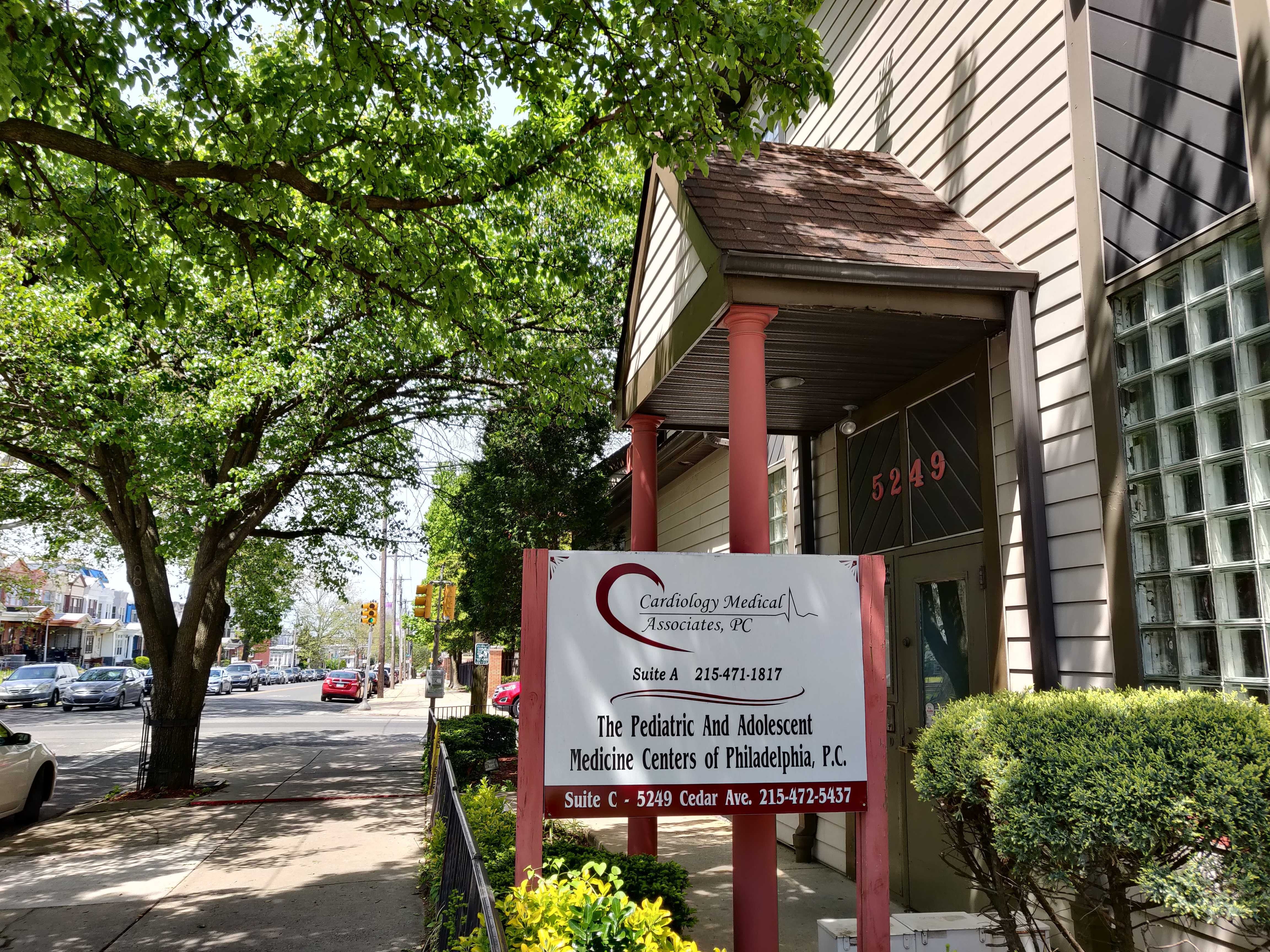
Although there have been local efforts by the Black Doctors COVID-19 consortium to ramp up testing, it is still mostly available only for those exhibiting symptoms. There has been a push in the area to ramp up antibody testing as well, but those tests may not be as reliable.
King worries about this approach to testing. He recounted a story from the family of one of his patients: The child is almost 2 years old, the mother had lost her sense of smell, and had called King for advice on how to keep the child safe – she’s a health care worker and was worried that she had gotten sick. The doctor advised that they all get tested, and he sent them to urgent care.
The child’s mother was able to be tested because she had symptoms, but the child’s father didn’t, so he wasn’t able to get tested. The mother was diagnosed with COVID-19. Because of the diagnosis, the father and child went to live with the child’s grandmother for a few days. By the end of the week, the father had lost his sense of smell and was worried that he had gotten sick as well.
They went to a different urgent care clinic, where the father was able to get tested, and he was diagnosed as well, so they returned to stay with the child’s mother. A few days later, the grandmother with whom the child and father had lived passed away.
“What is so crushing, as a clinician, is that we just needed one more test,” King said. “Just one more test, not for grandma, not for the baby, but for dad. They had two households, and they were trying to determine which was the safe house, but they didn’t know both were unsafe.”
He said he knows there is a testing shortage, but the way we are testing is fraught.
“We know exactly who the next patient will be,” said King. “When that patient gets sick and goes to the ER, that’s not when I need the test. By that point, it’s too late.”
King is also worried because his practice is, for the most part, serving the African American community, which has been the hardest hit during the pandemic.
“Each of us [physicians] are taking care of grandchildren of our original patients, but we really are taking care of up to five generations back, if you go back to the patients who referred us. We consider that continuity to be a real phenomenon.”
In mid-May, Pennsylvania Department Health data showed that although African Americans account for just 11.3% of the state’s population, they represented almost a third of the 22,725 COVID-19 cases at that time for which the race of the patient had been recorded.
“We can’t get ahead of the curve if you don’t let us check on the people who we believe are going to catch COVID and might have COVID. We can’t trace if we can’t test,” King said.
What all this will look like in the fall, or even come winter, is a concern, too, he said.
“I’m worried now, but I’m really going to be worried when everything blows up in September,” King said. “When the flu season hits and we don’t have the adequate tests to differentiate between coronavirus and flu, it’s going to be hard.”
The protests’ impact
On top of their regular worries, these private medical practices now have the added stress brought about by some factors of the recent protests, and the violence that is brought on by escalations between the police and demonstrators. The curfew has had an impact on their business, and they’ve had to close early to allow for their employees, as well as their patients, to get home safely and without harassment.
“The curfews do affect us because we have evening hours to accommodate for our patients who work during the day and are unable to take off,” Nguyen said. “Many of our patients use public transit to travel to the office, so now with the restricted schedules they may not be able to make it to our office anymore.”
Both King, the pediatrician, and Schwabe, the internist from Havertown, said they’re concerned for patients who haven’t been able to fill their prescriptions because their pharmacies have been looted. King said he’s also worried about some of his older teenage patients who have been out during the protests.
“I’ve had a few older teens who have been difficult to reach because they are going out to join the street battles that start at curfew time,” King said. “I have a teen patient who recently recovered from coronavirus last month, who was just hit by a car and fractured her leg [on] Sunday. Her surgery has been postponed a second day because the orthopedic surgeons at Einstein are overwhelmed with the minor trauma from the street battles over the last two nights.”
He fears the protests will also bring with them a new wave of coronavirus infections that could swamp the health care system in the coming weeks.

Show your support for local public media
WHYY is your source for fact-based, in-depth journalism and information. As a nonprofit organization, we rely on financial support from readers like you. Please give today.





![CoronavirusPandemic_1024x512[1]](https://whyy.org/wp-content/uploads/2020/03/CoronavirusPandemic_1024x5121-300x150.jpg)
